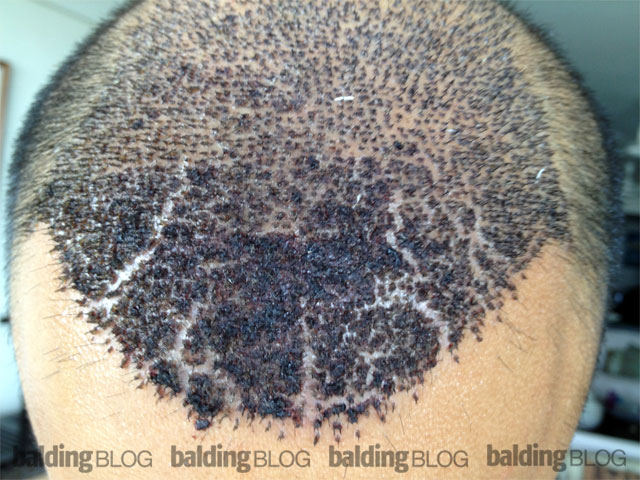Hi Doc,
I had a FUE done with 3000 grafts exactly 8 days ago (photo attached).
My concern is that there seems to have been a lot of scabbing or crusting (what is the difference between the two anyway?).
The scabbing/crusting started coming off in places near the restored hairline and it now looks like a river delta (i.e. lines where there is no hair/crusting/scabbing with pockets of crust/scab/hair).
Is this normal? Or is it due to trauma (e.g. scratching) or bad surgery? I know when I am awake, I do not touch the area (I have worn a bandana lightly from the day after the surgery, but only for a few days and first 2 nights). Sometimes at night, I inadvertently brush my hand against the recipient area and wake up.
My doctor advised me to start washing once a day from Day 2 onwards with a spray bottle with a mixture of baby shampoo and water (and rinsing with plain water from the spray bottle) which I have done.
Should I be trying to get rid of the scabs/crusts with light finger pressure when shampooing or should I wait for the 10th day before trying any of this? It is difficult to see the hair due to the black scabs/crusts, but the transplanted hair is there.
Thanks!


The crusting is very bad, which means that your management of your scabs was not good. We rarely, if ever, see this degree of crusting. How is the scabbing in the donor area at the back of your scalp?
Be very careful not to rush to take these crusts off. Use a shampoo and leave it on for 10 minutes and then gently, very gently rub in the shampoo. The crusts will slowly loosen and eventually they will come off. Give it another 10 days and hopefully the problem will be gone.
The scabbing/crusting (interchangeable words) is pretty intense, but hopefully there is no problem with the grafts because of it. Of course, follow up with your surgeon if you are concerned.

 I am doing really well. The back of my head as well as the region where the grafts were placed is virtually pain free and surprisingly I feel really good. I did make it home ok, although the flight home was terrible due to the lack of consideration by the person who was sitting next to me (he was a New Yorker).
I am doing really well. The back of my head as well as the region where the grafts were placed is virtually pain free and surprisingly I feel really good. I did make it home ok, although the flight home was terrible due to the lack of consideration by the person who was sitting next to me (he was a New Yorker).
